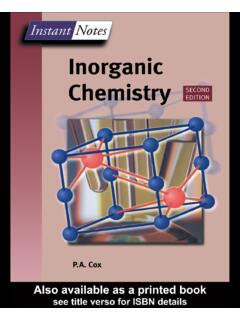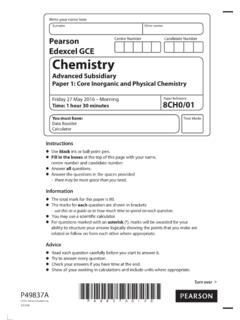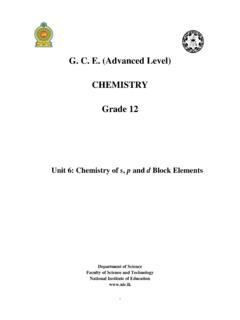Transcription of Compilation of Henry’s Law Constants for Inorganic and ...
1 Compilation of Henry s Law Constants for Inorganic andOrganic Species of Potential Importance in ~sander/ SanderAir Chemistry DepartmentMax-Planck Institute of ChemistryPO Box 306055020 MainzGermanye-mail: 3 (April 8, 1999)c Rolf Sander (non-commercial reproduction permitted)Contents1 Introduction32 The physical quantity of solubility33 Temperature dependence34 Unit conversions35 How to use the Tables46 Further Sources of Information47 Data Table ( Inorganic )6oxygen (O) ..6hydrogen (H) ..6nitrogen (N) ..7fluorine (F) ..8chlorine (Cl).
2 9bromine (Br) ..10iodine (I) ..11sulfur (S) ..12rare gases ..13other elements ..132R. Sander: Henry s law Constants ( ~sander/ )8 Data Table (Organic)14alkanes (C and H only) ..14cycloalkanes (C and H only) ..27aliphatic alkenes and cycloalkenes (C and H only) ..28aliphatic alkynes (C and H only) ..30mononuclear aromatics (C and H only) ..31terpenes and polynuclear aromatics (C and H only) ..35alcohols (ROH) (C, H, and O only) ..37polyols (R(OH)n) (C, H, and O only) ..41peroxides (ROOH) and peroxy radicals (ROO) (C, H, and O only) ..43aldehydes (RCHO) (C, H, and O only).
3 44ketones (RCOR) (C, H, and O only) ..46carboxylic acids (RCOOH) and peroxy carboxylic acids (RCOOOH) (C, H, and O only) ..48esters (RCOOR) (C, H, and O only) ..50ethers (ROR) (C, H, and O only) ..54miscellaneous, multiple functional groups (C, H, and O only) ..55compounds with nitrogen: amines (RNH2) (C, H, O, and N only) ..58compounds with nitrogen: amino acids (RCHNH2 COOH) ..59compounds with nitrogen: heterocycles (C, H, O, and N only) ..59compounds with nitrogen: nitrates (RONO2) (C, H, O, and N only) ..61compounds with nitrogen: nitriles (RCN) (C, H, O, and N only).
4 65compounds with nitrogen: nitro (RNO2) (C, H, O, and N only) ..66compounds with fluorine ..68aliphatic compounds with chlorine ..71aromatic compounds with chlorine ..82compounds with chlorine and fluorine ..84compounds with bromine ..86compounds with iodine ..89compounds with sulfur ..90polychlorobiphenyls (PCB s), pesticides, etc..929 Notes9610 Acknowledgements99 References99R. Sander: Henry s law Constants ( ~sander/ )31 IntroductionHenry s law Constants (solubilities) of trace gases of potential importance in environmental chemistry (atmospheric chem-istry, waste water treatment.)
5 Have been collected and converted into a uniform : Although this Compilation has been edited with greatest care the possibility of errors cannot be excluded. Ifyou use data from this table it is recommended that you also check the original literature. If you find an error in this table,please tell me about it!2 The physical quantity of solubilityThere are several ways of describing the solubility of a gas in water. Usually the Henry s law constantkHis defined as:kHdef=ca/pg(1)Here,cais the concentration of a species in the aqueous phase andpgis the partial pressure of that species in the gas to standard conditions (T = K) it will be denoted ask s law constant can also be expressed as the dimensionless ratio between the aqueous-phase concentrationcaof aspecies and its gas-phase concentrationcg:kccHdef=ca/cg=kH RT(2)whereR= gas constant andT= temperature.
6 To distinguish these different physical quantities, this constant has the reciprocal valuekpxH,invis used, representing the volatility instead of the solubility. The usual definition is:kpxH,invdef=pg/xa=%H2 OMH2O kH(3)wherexa= molar mixing ratio in the aqueous phase,%H2O= density of water, andMH2O= molar mass of Temperature dependenceA simple way to describe Henry s law as a function of temperature is:kH=k H exp( solnHR(1T 1T ))(4)where solnH= enthalpy of solution. Here, the temperature dependence is: d lnkHd(1/T)= solnHR(5)4 Unit conversionsDetailed information about the conversion between different units and definitions of Henry s law Constants is given bySander[1999].
7 Here is a short summary:The commonly used unit forkHis [M/atm] = [molaq/dm3aqatm]. The official SI unit is [molaq/m3aqPa]. The conversion is:kH[M/atm]= kH[(molaq/m3aq)/Pa](6)The relation betweenkHandkccHis:T[K] kH[M/atm]= kccH(7)4R. Sander: Henry s law Constants ( ~sander/ )AtT= K this leads to:kH[M/atm]= kccH(8)The commonly used unit forkpxH,invis [atm]. The product ofkHandkpxH,invis constant:kH[M/atm] kpxH,inv[atm]= (9)5 How to use the TablesInorganic substances are sorted according to the elements they contain. The order chosen is: O, H, N, F, Cl, Br, I, S, raregases, substances ( everything with carbon, including CO and CO2) are sorted somewhat arbitrarily by increasingchain length and complexity.
8 Hetero atoms (N, F, Cl, Br, I, and S) are sorted in the same way as for Inorganic column labeled substance gives the systematic name, the chemical formula, trivial names (if any), and in several casesthe CAS registry number (in square brackets).The column labeled k H contains the Henry s law Constants as defined in equation (1), rounded to two significant digitsand given in the unit [M/atm].The column labeled d lnkH/d(1/T) contains the temperature dependence of the Henry s law Constants as defined inequations (4) and (5), rounded to two significant digits and given in the unit [K].
9 For each table entry the column labeled type denotes how the Henry s law constant was obtained in the given reviews are usually most reliable, followed by original publications of experimental determinations ofkH. Otherdata has to be treated more carefully. The types listed here are roughly ordered by decreasing reliability: L The cited paper is a literature review. M Original publication of a measured value ( head-space or bub-ble column technique as explained byBetterton[1992]). V Vapor pressure of the pure substance is used to determine theHenry s law constant (c/pfor a saturated solution).
10 R The cited paper presents a recalculation of previously publishedmaterial ( extrapolation to a different temperature or concen-tration range). T Thermodynamical calculation ( solnG= RTlnkH, seeSander[1999] for details). C The paper that is cited here refers to another reference whichI could not obtain ( personal communication, theses,internal papers etc.). X I haven t seen the paper that I cite here. I found it referenced byanother paper or I know about it through others. ? The cited paper doesn t clearly state how the value was obtained. E The value is estimated.








